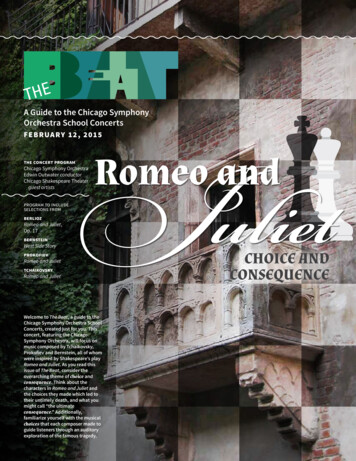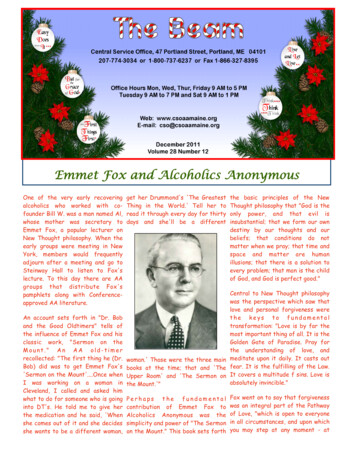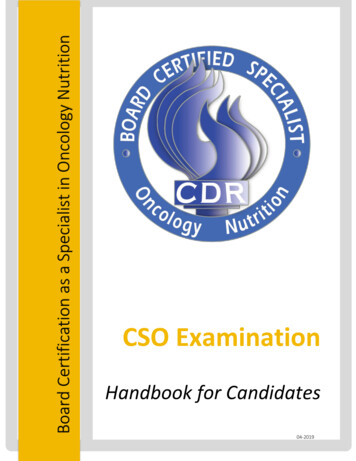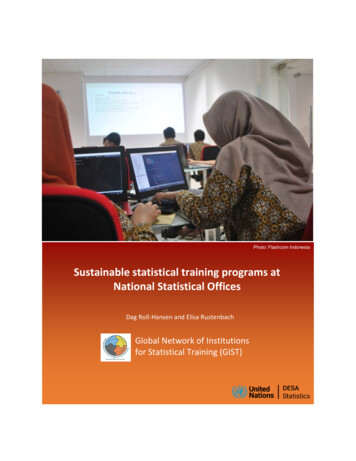
Transcription
THEA Guide to the Chicago SymphonyOrchestra School ConcertsJulietFE B RUA RY 12 , 201 5the concert programChicago Symphony OrchestraEdwin Outwater conductorChicago Shakespeare Theaterguest artistsprogram to includeselections fromberliozRomeo and Juliet,Op. 17bernsteinWest Side StoryprokofievRomeo and JuliettchaikovskyRomeo and JulietRomeo andWelcome to The Beat, a guide to theChicago Symphony Orchestra SchoolConcerts, created just for you. Thisconcert, featuring the ChicagoSymphony Orchestra, will focus onmusic composed by Tchaikovsky,Prokofiev and Bernstein, all of whomwere inspired by Shakespeare’s playRomeo and Juliet. As you read thisissue of The Beat, consider theoverarching theme of choice andconsequence. Think about thecharacters in Romeo and Juliet andthe choices they made which led totheir untimely death, and what youmight call “the ultimateconsequence.” Additionally,familiarize yourself with the musicalchoices that each composer made toguide listeners through an auditoryexploration of the famous tragedy.CHOICE ANDCONSEQUENCE
S#2To help you determine what musical choices the composersmade when writing their music, please use the listening toollocated on the back of this document.Act 2Track #3 illustrates the lush sound of the full orchestra playing the love theme.The love theme from Tchaikovsky’s Romeo and Juliet conveys thecouple’s first meeting at the masquerade party as well as thescene at Juliet’s balcony. Tchaikovsky chose to demonstratethe love between these two young people by writing a melodythat ascends upward with lush strings supporting the soaringmelody. By choosing to have the melody interrupted withcrashing cymbals, Tchaikovsky announces the suicides ofRomeo and Juliet.The opening of Tchaikovsky’s Romeo and Juliet depicts FriarLaurence and is written in a chorale style to evoke the sounds youmight hear in a Catholic Church. The slow introduction, with theclarinets and bassoons playing the somber “Friar Laurence” theme,is interrupted by a foreboding melody played by the strings. Thewoodwinds join in a series of prayer-like chords accented by upwardmoving notes of the harp.Although Friar Laurence is a wise adviser to Romeo and Juliet, hisplan to bring the couple together—and to unite the Montaguesand Capulets—unravels right before his eyes.TRA#4After the battle is over, the music becomes much slower and dirge-like.What musical elements make this music sound like it is accompanyinga funeral?The consequence: The lovetheme from Tchaikovsky’sRomeo and Juliet is one of themost recognizable melodiesever written. It has been usedin numerous movies and playsto amplify the love betweentwo characters.CKListen to Track # 4. The love theme quickly transitions into abattle between the two warring families. What are the musicalelements Tchaikovsky chose to make this music sound like a battle?After the Romeo and Juliet Fantasy Overture premiered, Balakirevwas quick to criticize the piece. Consequently, Tchaikovsky choseto revise the piece two more times. He also pulled inspiration fromthe text of the story and would often reread the play to enhance hisideas. In 1890, it reached its final form and is now one of his mostbeloved pieces, adored by audiences around the world.23Listen to Track #2. The voices of Romeo and Juliet areheard is this section of the love theme. The English hornrepresents Romeo and the flute represents Juliet.Pyotr (Peter) Ilyich Tchaikovsky wrote his Romeo andJuliet Fantasy Overture in 1869 when fellow Russiancomposer Mily Alexeievich Balakirev challenged him to write musicthat expressed the themes of the story. Tchaikovsky chose to acceptthe challenge and captured the major facets of the story and itsspirit in his composition.FRIAR a member of anycertain religious orders ofmen in the RomanCatholic Churchand #Listen to Track # 1. What were the musical choicesTchaikovsky made to depict Friar Laurence?TR ACKWrite about a time when you had to make a choiceand face a consequence as a result of that choice.#1In the city of Verona live two noble families, theMontagues and the Capulets, who have been atodds for generations. Within the walls of thiscity live two young people, Romeo, a memberof the Montague house, and Juliet, a memberof the Capulet family. Romeo and Juliet appearat a masquerade ball hosted by Lord Capulet.Romeo goes to the party hoping to seeRosaline, his first love, while Juliet attendshoping to see if she will ever fall in love withParis, the man who has been promised herhand in marriage. Romeo’s choice to attend theparty consequently results in the two youngpeople falling in love with each other.What were the consequencesof Friar Laurence’s choices?ACKAct 1TRDIRGEa lament forthe deadListen to Track # 4 again and notice how the major chords seem to give the piecea hopeful ending. Why do you think Tchaikovsky chose to end this piece ofmusic in this way? What is the consequence for the listener?3
Listen to Track #6, The Death of Tybalt. What musical choices didProkofiev use to make this music sound like playful fighting?TRAct 3ACK #6Sergei Prokofiev strongly believed that music was meant to “beautifyhuman life” and “to point the way to a radiant future.” He chose tocompose music that his audiences would appreciate andconsequently remember.Prokofiev’s Romeo and Juliet has become one of the greatestcompositions for the ballet stage. However, prior to its premiere, itwas rejected by two ballet companies as a consequence for being“impossible to dance to” and containing a “happy ending” thatProkofiev initially chose to write, despite how the play really ends. Bythe time the ballet premiered in 1938, Prokofiev rewrote this piece toexpress the tragic ending of the original story with music thatbeautifully captures the saga, combining the lightness of the lovestory with the violence that ensues. Prokofiev’s Romeo and Julietexpertly evokes the emotion of the drama through the musicalchoices he made for this ballet.fun fact! In January1937, Sergei Prokofiev ledthe Chicago SymphonyOrchestra in selectionsfrom his new, still-unstagedballet, Romeo and Juliet.Chicago was the firstAmerican city to hear thisnew music.Prokofiev’s Romeo and Juliet differs from Tchaikovsky’s FantasyOverture in that the music tells the complete story. The beginning ofthe section titled Montagues and the Capulets expresses the tensionfelt by the warring families and quietly foreshadows the impendingdeaths of Romeo and Juliet. Notice the choice Prokofiev made tocompose long, low notes for the string bass in this piece. Can youhear how each family is striding back and forth, stewing in its anger,trying to calculate what each family’s next move might be?Romeo’s best friend Mercutio is disgusted that Romeo won’tfight Tybalt, so Mercutio accepts Tybalt’s challenge instead.Romeo attempts to block the fight, but Tybalt manages to stabMercutio under Romeo’s arm and kills him. Romeo, irate over hisbest friend’s death, picks up the sword and in turn kills Tybalt.Listen to Track # 6 again. Notice how Prokofiev choseto have the string musicians hit the strings with thestick of the bow. What do you think Prokofiev isportraying by using this musical technique?Track #7, The Death of Tybalt. As you listen to the rest ofthis piece, describe how the music changes to soundlike a more serious and dangerous fight. What musicalchoices did Prokofiev make to create music thatsounds ominous?Leonard Bernstein was aworld-renowned conductorCTR A K #6and the music director of the New YorkPhilharmonic, as well as an extremelygifted composer. In the 1950s, Bernstein,Arthur Laurents, Stephen Sondheim andJerome Robbins created a modern-dayversion of William Shakespeare’s Romeo andJuliet called West Side Story. Leonard Bernsteinwas influenced by many different musical styles:classical, pop, Latin and jazz, and wasconsequently able to pick and choose fromACK #7Reach of these styles when writing the musicTfor this production.In the Death of Tybalt, the music starts out playfully, as does this scene in the play.Tybalt, Juliet’s cousin, is still angry that Romeo went to the Capulet’s masqueradeparty. Tybalt challenges Romeo to a duel, but Romeo declines because he doesnot want to fight his kin by marriage.TR ACK#54Listen to Track # 5. What other musical choices did Prokofiev make toillustrate the two families at war with each other? Discuss whichmusical elements in The Montagues and the Capulets captures the feelingsof the families.Here is what Arthur Laurents recalled after hearingBernstein’s music at the very first run-through of the musical:“ It was the best theater music that’s everbeen written. He didn’t think. The musicjust poured out of him. He had thatrare quality of being able to feel eachcharacter; he was a musical dramatist.”Act 4West Side Story is set in the Upper WestSide neighborhood of New York City andportrays the rivalry between the Sharks, agang of Puerto Rican youth, and the Jets, awhite gang that likes to antagonize the Sharks.Tony (Romeo) used to lead the Jets. Maria’s(Juliet’s) brother is the leader of the Sharks. Tonyand Maria fall in love at the school dance whenthey spot each other across the crowdedgymnasium. Their love for each other threatensthe rival gangs, which causes the groups to fight.Despite his choice to call for peace, Tony endsup fighting and accidently killing Maria’s brother.This act consequently leads to Tony’s death andMaria’s hardened heart toward everyoneinvolved.Leonard Bernstein chose to start the Rumble in avery dramatic way with the timpani signaling thedanger at hand. Following the loud bang on thetimpani is a fanfare played by the brass,announcing that the fight has begun.5
EpilogueTRThe choreography notes, written by Jerome Robbins and found with Bernstein’smusical sketches for Rumble, influenced the musical choices Bernstein madewhen writing this music. One section Bernstein titled “cat-play” is a description ofhow the dancers would move to the music.ACK #8Listen to Track #8, Rumble. What other musical elements did Bernsteinchoose to incorporate to make this piece sound like a fight betweentwo rival gangs?How is this music similar to or different from the fight music written byTchaikovsky and Prokofiev?Listen to tracks 4, 7 and 8 again. Which composer best illustrated a fight?Explain your answer.When writing Somewhere for West Side Story, Bernstein chose to pay homage toBeethoven and Tchaikovsky by using a phrase from Beethoven’s Emperor PianoConcerto and a phrase from Tchaikovsky’s Swan Lake to create the slow, sombermelody of this song.9TR ACK #Listen to Track # 9 Somewhere. What emotions does this music evoke?What musical elements did Bernstein choose to use that contributemost to making you feel this way?HAPPY6CALMSADEXCITINGWe are all faced with choices every day. Just likethe characters in the play, sometimes weconsider the consequences of our choices andsometimes we don’t. Usually the price we pay isnot as dire as the price paid by the two star-crossed lovers. One couldargue that young people, like Romeo and Juliet, do not have enough lifeexperience to realize that their individual actions can lead to their ownsuccess or demise. One could also argue that some individuals neverpay attention to the choices they make and never realize that for everyaction and inaction in life there is a consequence. What we do know isthat William Shakespeare conveyed life’s tragic consequences in a waythat continues to captivate readers, connecting with their own feelingsand experiences. That is why we still read his plays and why composersare inspired to write music based on his stories 400 years after his death.AT THE CONCERTThe ConductorEdwin Outwater is Music Director of Ontario’s KitchenerWaterloo Symphony (KWS), Director of Summer Concerts at theSan Francisco Symphony and regularly guest conducts theChicago Symphony Orchestra and the New World Symphony.Edwin has also conducted the New York Philharmonic, LosAngeles Philharmonic and Seattle Symphony, among many others. Edwin Outwater’swork in music education and community outreach has been widely acclaimed. In 2004his education programs were given the Leonard Bernstein Award for excellence ineducational programming, and his Chinese New Year Program was given the MetLifeAward for community outreach.The Chicago Shakespeare TheaterChicago Shakespeare Theater (CST) is a leading international theater company andthe recipient of the Regional Theatre Tony Award . Under the leadership of ArtisticDirector Barbara Gaines and Executive Director Criss Henderson, CST is dedicated tocreating extraordinary production of classics, new works and family programming; tounlocking Shakespeare’s work for educators and students; and to serving as Chicago’scultural ambassador through its World’s Stage Series. CST attracts 225,000 audiencemembers annually and is proud to take an active role in empowering the nextgeneration of literate, engaged cultural champions and creative minds.David Bell has written the script and directed this production of Romeo and Juliet.His work as a director, choreographer and writer in Chicago has earned him elevenJeff Awards and forty-five nominations.The OrchestraFounded in 1891, the ChicagoSymphony Orchestra isconsidered one of the greatestorchestras in the world. Incollaboration with the bestconductors and guest artists fromaround the world, the CSOperforms well over 100 concertseach year at its downtown home,Symphony Center, and at theRavinia Festival on Chicago’sNorth Shore, where it is inresidence each summer. Throughthe Negaunee Music Institute, theCSO engages nearly 200,000Chicago-area residents annually.Music lovers outside Chicagoenjoy the sounds of the ChicagoSymphony Orchestra not onlythrough its Chicago SymphonyOrchestra Radio Broadcast Seriesand best-selling recordings on itshighly acclaimed record labelCSO Resound, but also throughfrequent sold-out tourperformances across the UnitedStates and around the globe.7
LISTENING TOOLAs you listen to each of the selections inside, consider how each musical element evokes the ideas beingportrayed in each piece of music. In some cases, more than one word may be chosen for each element.Musical ElementDescriptionInstrumentationstrings (violin, viola, cello, bass)woodwinds (flute, clarinet, oboe, bassoon, etc.)brass (tuba, trombone, french horn, trumpet, etc.)percussion (timpani, xylophone, cymbals, etc.)other (e.g., synthesizer or electronic instruments, “found” percussion, etc.)Tempopresto (very fast)allegro (fast)andante (moderate, walking tempo)largo (slow)Dynamicspianissimo (very quiet)piano (quiet)mezzoforte (medium-loud)forte (loud)fortissimo (very loud)Articulation/Expressionlegato (smooth and connected)staccato (short and percussive)rubato (give and take with tempo and rhythm)accelerando (getting gradually faster and faster)ritardando (getting gradually slower and slower)Form/Structurerepetitive (the exact same musical idea occurs again and again)predictable (sections of the piece recur in an expected way)thematic (the same general musical idea is restated, though not exactly the same way each time)contrasting (sections sound very different from one another)What instruments of the orchestra arefeatured?How fast or slow does the music go?How loud or soft is the music played?How are the notes played?How did the composer organize the music?Major ContributorsThe Institute is endowedby a generous gift fromThe Negaunee Foundation.THE 100,000 AND ABOVEEach year, the Chicago Symphony Orchestra invests in innovativelearning and training programs that engage more than 200,000children and adults. These programs would not be possiblewithout the generous support of the following donors.Elizabeth F. Cheney FoundationJudson and Joyce GreenThe Julian Family FoundationSusan and Richard KiphartRobert R. McCormick FoundationThe James and Madeleine McMullanFamily FoundationThe Negaunee FoundationPolk Bros. FoundationDONOR SPOTLIGHT 50,000– 99,999The Crain-Maling Foundation is proud to sponsor the CSOYouth Auditions, a competition that shines the spotlight onmany of the young musicians who will delight the world throughtheir future musical performances. The Foundation’s mission isto help make ours a better world.Alphawood FoundationRobert and Joanne Crown IncomeCharitable Fund, in memory ofJoanne Strauss CrownLloyd A. Fry FoundationJohn Hart and Carol PrinsJudy and Scott McCueorchestraNational Endowment for the ArtsThe Claire Rosen & Samuel EdesFoundationBarbara and Barre Seid FoundationMrs. Peg Sindelar 25,000– 49,999Anonymous (2)Abbott FundBarker Welfare FoundationJohn and Fran EdwardsonEllen and Paul GignilliatPeter G. Horton Charitable RemainderAnnuity TrustRobert Kohl and Clark PellettLeslie Fund, Inc.Bowman C. Lingle TrustAnn and Robert H. Lurie FoundationMazza FoundationThe Pauls FoundationMichael and Linda SimonU.S. Bank FoundationUnited AirlinesMr. & Mrs. John E. Van HornENDOWED FUNDSAnonymous (3)Cyrus H. Adams Memorial YouthConcert FundDr. & Mrs. Bernard H. AdelsonMarjorie Blum-Kovler Youth ConcertFundCNAKelli Gardner Youth EducationEndowment FundMary Winton GreenWilliam Randolph Hearst FoundationFund for Community EngagementRichard A. HeisePeter Paul Herbert Endowment FundLester B. Knight Charitable TrustThe Malott Family Very SpecialPromenades FundThe Eloise W. Martin Endowed Fundin support of the Negaunee MusicInstitute at the Chicago SymphonyOrchestraNancy Ranney and Family and FriendsToyota Endowed FundThe Wallace FoundationTo make a gift in support of the work of the Negaunee MusicInstitute at the CSO, call 312-294-3100 or visit cso.org/give.The Beat is a publication of the Negaunee Music Institute. Content created by KatyClusen. Graphic design by Emma Bilyk. Listening Tool created by Brenda K. Fineberg.
Chicago Shakespeare Theater guest artists program to include selections from berlioz Romeo and Juliet, Op. 17 bernstein West Side Story prokofiev Romeo and Juliet tchaikovsky Romeo and Juliet Welcome to The Beat, a guide to the Chicago Symphony Orchestra School Concerts,










